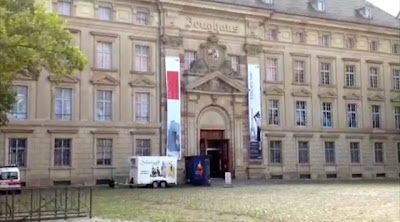This week I have been to Mannheim (Germany) to see the first photographs that was made by a camera. It is part of the exhibition "Die Geburtsstunde der Fotografie / The Birth of Photography" in the Reiss Engelhorn Museum.
I went to Mannheim only to see this photo. The rest was interesting and nice, but not sufficient reason to travel to Mannheim and stay there for a couple of days. The 1826 Niepce photograph was worth all the trouble. For me it was a very exiting moment to see the Point de vue du Gras in real and from only a few centimeters distance. It was the chance of a lifetime and something that I will not forget.
It was not allowed to take photos at the exhibit, so I can't show you any pics from my visit to the rooms. But here are some photographs from the internet.
 |
| The photo in its original frame, photo by the Harry Ransom Center, Texas, that owns the Point de vue du Gras. This comes closest to what I have seen in Mannheim. |
 | ||||
| This is a digital scan that also give a good impression of what the photo looks like. In real you can't see all the parts at once, as you have to move your head to view the plate from different angles to see what is on it. The three bumps in the corners were made in 1952 when they tried to photograph the plate at Kodak.
|
What I will do is provide some more information about the exhibition. If you want to see it, you can do so until January 6, 2013. After that the Point de vue du Gras will return to Austin, Texas.
 There is a beautiful and well made catalog available, with all the 250 photos, for € 30 at the museum. It can also be bought online (probably for a higher price). The first 80 pages are devoted to Helmut and Alison Gernsheim, who founded the Gernsheim collection of historical photographs that is now at the Harry Ransom Center. Then there are about 10 pages on the Point de vue du Gras. Pages 96 to 274 show all the photos, accompanied by short descriptions. In the appendix there is an index on names and some information about the development of photography. It is bilingual: German and English.
There is a beautiful and well made catalog available, with all the 250 photos, for € 30 at the museum. It can also be bought online (probably for a higher price). The first 80 pages are devoted to Helmut and Alison Gernsheim, who founded the Gernsheim collection of historical photographs that is now at the Harry Ransom Center. Then there are about 10 pages on the Point de vue du Gras. Pages 96 to 274 show all the photos, accompanied by short descriptions. In the appendix there is an index on names and some information about the development of photography. It is bilingual: German and English.The book has hard covers and measures about 24 x 30 cm.
The photos on display are a mix of old and "modern" works. There a some important daguerreotypes, like the full plate Notre Dame and the Ile de la Cite, made by Louis Daguerre himself in 1838. Also there is a salt paper print by Fox Talbot, The Bridge of Sighs, St. John's College, about 1845. Other well known photographers include Berenice Abbott, Ansel Adams, Paul Strand and Francis Frith, Felix Beato or Herbert Ponting, to name a few. All the big names are there, but only with one or two photos.








